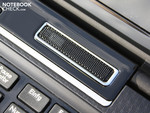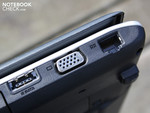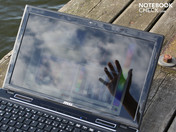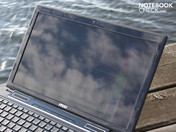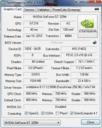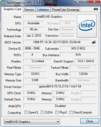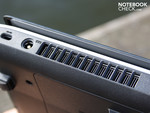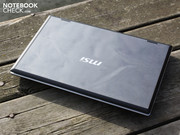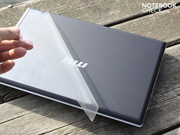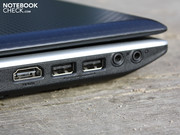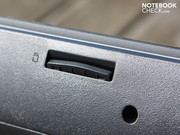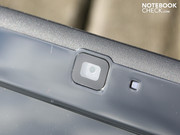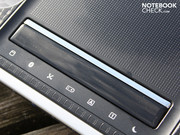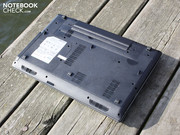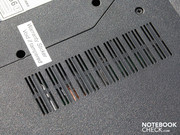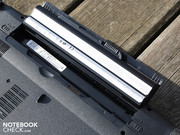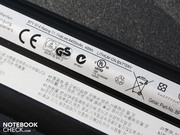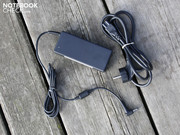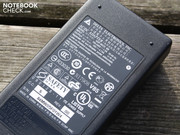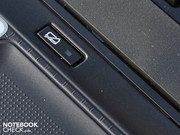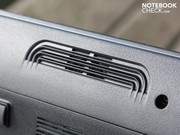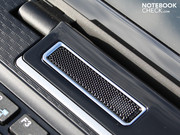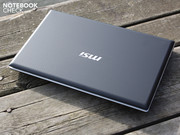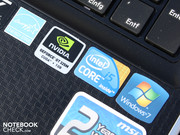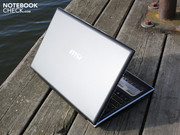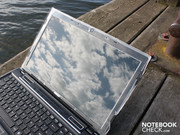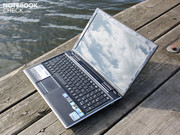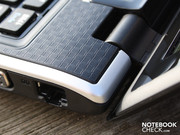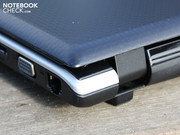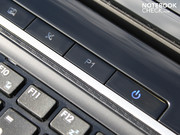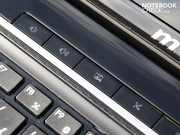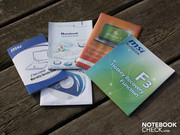Review MSI FX600 Notebook

First present at CeBIT 2010, the FX series has now finally arrived on the shop floors. Technically, it's a mid-range laptop in the price range up to 800 Euro. With a i5-450M processor and GeForce GT 325M with energy saving through Nvidia Optimus the FX600 is technologically up to date. The all-rounder can thus interchangeably use two graphics cards. The Nvidia driver automatically switches between the GT 325M and the economical Intel GPU. In this way, users can use the FX600 for games (GT 325M) and, for example, the train journey (Intel HD).
However, the speciality of the 15.6-incher isn't found in the performance, but rather in the sound system with four loudspeakers (THX certified). Additionally the manufacturer takes a chance with a new barebone, replacing the previously glossy, lacquered surfaces with a non-slip surface finish.
What does the FX600 offer for 799 Euro? Can Nvidia Optimus provide a considerable battery life, despite the low battery capacity? Is the sound of the four loudspeakers really convincing? Is the GT 325M capable of handling games? These and other questions are answered in our extensive test report.
Case
The case of the FX600 is suitable for both the office, student digs or home because of its matte and non-slip texture (working environment and lid).
Office typists get a non-slip working area, which has no fear of dirty fingers and scratches. The only glossy surfaces are the black display border and of course the display itself. The plastic cage of the keyboard is additionally a dust collector, which separates the keys from one another. The spaces between the keys noticeably serve up the dust. However, after pressing down the keys this area can be cleaned.
The case is suitably stable but less rigid as we would have expected from the CeBIT mock up. With both hands we can bend it, admittedly to a limited extent. The wrist rest can be depressed with some pressure around the stickers. The same goes for the base plate and the lid surface. We can only slightly warp the lid with two hands. Overall the stability is adequate but not above average for home use.
The hinges are seated firmly on the base unit. They are very taut, so much so that we needed to use both hands when opening the lid. The maximum opening angle is sufficient for use on the lap (around 130 degrees). The large flap on the underside allows the user to change the hard disk, RAM or WLAN module. For the Core i5 processor this is also theoretically true.
Connectivity
The 15.6-incher only comes along with a minimum of connections for the multimedia standard. Neither ExpressCard nor FireWire nor analogue 7.1 audio jacks found their way into the case. All the same, film enthusiasts can connect external hard drives via the fast eSATA interface and thus move films in a matter of seconds. External displays can be connected by the user via HDMI or VGA.
Data can also be transferred at the highest speed over the Ethernet cable (Realtek Gigabit LAN). The same goes for the Intel WiFi Link 1000: the WLAN card has Draft-N support (b/g/n).
Input Devices
Keyboard
MSI deploys free-standing keys inclusive of a number pad for fast number input. The keys have a good amount of space between each other, yet offer the typist a short, dull key stroke. Unfortunately the pressure point isn't particularly well-defined, which is the reason for an unsatisfactory typing feel. The key surface is overall rather firm.
Despite the distance between the keys there are grounds for criticism. The keys of the number block and the arrow-, enter- and shift-keys are unnecessarily small and greatly wedged in. Here you can easily mistype. Displacing the arrow keys in the direction of the wrist rest could have separated them from the other keys.
The five hardware keys are seated subtly above the keyboard, which serve volume, the CinemaPro modde, WLAN and opening a program (adjustable). MSI's own eco mode (TurboBattery, Gaming etc.) is opened via the eco-inscribed Fn key (F5).
Touchpad
The multi-touch pad (Elan Smart-Pad 5.1) has no vertical and horizontal scrollbars. It is also not possible to activate these in the Elan Smart Pad software. However, scrolling or zooming with two fingers is possible via gestures. Users can scroll vertically and horizontally with two fingers on the pad. The keys require a high pressure point, but are clicked relatively quietly. Their glossy surface contrasts the matte, lightly dotted touchpad. Fingers glide with a good amount of grip over the small pimples. The oily film from sweaty hands is thus a thing of the past.
Display
The 15.6 inch display (Samsung 156AT05-H01) has a resolution of 1366 x 768 pixels (HD ready). The glare panel has room to improve with a low contrast of 161:1. High contrasts point to bright colours and deep black. As it was, the display lacked jazzy, intensive colours. Black has a light, grey haze.
| |||||||||||||||||||||||||
Brightness Distribution: 87 %
Center on Battery: 204 cd/m²
Contrast: 161:1 (Black: 1.27 cd/m²)
The measurement of the background lighting brightness shows no more than average results. On average brightness is at 198 cd/m². The illumination is consistent (87 percent) as the TFT obtains 210 cd/m² in the brightest area and 182 cd/m² in the weakest. Indoors, brightness of 150 cd/m² is sufficient. When outdoors it could become difficult.
If you go into the sun with the FX600, you won't have much fun surfing, writing or gaming. The TFT panel lacks an anti-glare coating that prevents reflections. The brightness of 198 cd/m² also doesn't protect against reflections. It's too weak to fight against the bright light of the sun. The FX600 can thus only resign from duty as a mobile companion on the terrace.
The vertical viewing angles are very small, whilst the horizontal viewing angles are relatively liberal. Horizontally our eyes can deviate up to 40 degrees. Only then do colours become almost completely distorted. Vertically, colours fade and invert even at a deviation of 10 degrees frontally. In a photo darkroom the small vertical viewing angles are clearly visible.
The small viewing angles are problematic for the MSI FX600 as an entertainment laptop. If you watch a film for four or want to watch holiday videos, you'll constantly be worrying about an image that's too dark or unrecognisable because it has become inverted. A constant adjustment of the display is the consequence.
Performance
MSI equips the i5447W7P version of the FX600 with an Intel Core i5-450M. The 32nm CPU is a strong mainstream processor. It has two physical cores that each clock at 2.4 GHz (standard speed). Through Turbo Boost this can be between 2.4 and 2.66 GHz. The applications (not the user) ascertain how many cores should increase their clock speed. Additionally there's hyper-threading. The CPU feature provides an extra virtual core for each physical core. Applications can thus compute on four threads.
A novelty of the Core i5 processors from 2010 is the integration of the memory controller and the GPU into the processor package. The Intel HD in the FX600 works in cooperation with Nvidia Optimus. This technology allows switching between the energy-efficient IGP graphics and a dedicated Nvidia GPU without interruption. In the case of the FX600 there's an Nvidia GeForce GT 325M. The previously standard hardware switch for the hybrid graphics is omitted. Turning off the GT 325M should increase the battery life in unassuming use.
| PCMark 05 Standard | 6346 points | |
| PCMark Vantage Result | 4558 points | |
Help | ||
PCMark Vantage rates the combination of CPU, graphics, RAM and hard disk. Its overall result of 4558 points turns out lower than expected, as Core i3-330M systems with dedicated graphics cards typically reach up to 5000 points (e.g. Acer Aspire 8942G-334G64Mn: 4755 points). I5-450M systems like the Dell Vostro 3300 (Core i5 450M, GMA HD) can also reach 5416 points. A reason for the low PCMark Vantage score is the low HDD score in the test. The FX600 achieves 3232 points; the aforementioned Vostro 3300 achieves a better score of 3918 points.
Clearly better performing laptops are equipped with Core i5-520M. These systems, with normal hard disks (no SSD) have between 5500 and 6.000 Vantage points (e.g. Samsung NP-R580-JS03DE: 6026 points). The gaming score is obtained using the Geforce GT 325M (4544 points). Applications that profit from the hardware acceleration of the GT 325M (CUDA, DirectX Compute, OpenCL, H.264), are sped up by the dedicated GPU.
| 3DMark 03 Standard | 13916 points | |
| 3DMark 05 Standard | 9933 points | |
| 3DMark 06 Standard Score | 5373 points | |
| 3DMark Vantage P Result | 2157 points | |
Help | ||
The hard disk (Western Digital WD5000BEVT-22A0RT0) has a capacity of 500 GB and runs at the standard speed of 5400 RPM. HDTune records a below average score of 50.4 MB/s in sequential reading. Additionally the access time is relatively slow at 19 ms. 7200 RPM hard disks have an access time of around 15 ms. The WD disk shows its slowness in the PCMark Vantage HDD score at 3232 points.
Gaming Performance
As a dedicated GPU, a Nvidia GeForce GT 325M comes into play with 1024 MB DDR3 memory. The core is clocked at 450 MHz, the memory at 700 MHz. The DirectX-10.1 GPU supports video decoding (H.264, VC-1, MPEG-2) and relieves the processor of load. Also the Nvidia-typical CUDA, DirectX Compute, OpenCL and PhysX characteristics are on board and support the computing work of the processor in particular applications.
In 3DMark06 the 3D accelerator reaches 5373 points. Thus the GT 325M is under the level of a GT 330M. This also confirms the gaming performance. In the following tests the GT 325M constantly limps behind the GT 330M and of course the HD 5650. We tested Metro 2033, Anno 1404 and the Call of Juarez Benchmark.
Metro 2033
The demanding shooter is a model for a hardware-intensive 2010 game. Even GPUs of the upper mid-range like the HD 5650, HD 5730 or GT 330M can't provide a frame rate of more than 30 FPS in high details. We only tested it in medium and was played at 24.4 FPS. Only at minimum settings the shooter runs fluidly (35.5 fps), but the pixelated graphics leaves little atmosphere remaining. If you'd like to play Metro 2033 on a laptop with at least medium details, you at least need a GeForce GTX 285M or a HD 5870.
| Metro 2033 | |||
| Resolution | Settings | Value | |
| 1360x768 | Normal DX10, AAA, 4xAF | 24.4 fps | |
| 800x600 | Low DX9, AAA, 4xAF | 35.5 fps | |
Anno 1404
Blue Byte's strategy epic is also unplayable fluidly in high details. As the frame rate is very high at low details, gamers will have luck somewhere in the middle, at medium details and a low resolution (1024 x 768). In order to play Anno 1404 fluidly at high details, you at least need a GeForce GTX 260M, HD 5730 / HD 5850 or a HD 5650 paired with a fast quad-core processor (Deviltech Fire DTX, i7-720QM).
| Anno 1404 | |||
| Resolution | Settings | Value | |
| 1280x1024 | very high, 0AA, 4AF | 18.4 fps | |
| 1024x768 | low, 0AA, 0AF | 89.6 fps | |
Gaming Verdict
Geforce GT 325M and 5373 3DMarks06 – if you regularly want to play demanding games, you'll stay well away. Only with an ATI HD 5650, HD 5870 or GTX 280M can the real gaming fun begin. Gamers have to put up with real losses in details and resolution with the GT 325M in the MSI FX600. Details of the performance of different current games are to be found in our games list.
| low | med. | high | ultra | |
|---|---|---|---|---|
| Call of Juarez Benchmark (2006) | 13.8 | |||
| Anno 1404 (2009) | 89.6 | 18.4 | ||
| Metro 2033 (2010) | 35.5 | 24.4 |
Emissions
System Noise
Without load (idle) or with very low office load the noise level doesn't climb above 33.1 dB(A). The Western Digital HDD sporadically makes itself known with an audible clacking of the read/write head. If you want to comfortably watch a DVD film, you'll unfortunately be disturbed by a constantly loud optical drive. This clamours around and is clearly audible at 37 dB(A). Luckily the good sound system can drown out this noise.
In the stress test, in which the CPU and GPU are fully loaded, we managed to force the FX600 up to the 48.1 dB(A) mark. At this level the fan bellows almost like a siren, only not as piercingly. In games and constant 3D load the sound remains clearly more pleasant at 39 dB(A).
Noise level
| Idle |
| 32.5 / 32.7 / 33.1 dB(A) |
| HDD |
| 33.1 dB(A) |
| DVD |
| 37 / dB(A) |
| Load |
| 39.2 / 48.1 dB(A) |
 | ||
30 dB silent 40 dB(A) audible 50 dB(A) loud |
||
min: | ||
Temperature
If the 15.6-incher just remains idle, the average temperature of the underside is only 30 degrees Celsius. The wrist rest remains pleasant at 32 degrees. It's surprising how evenly the heat waste is distributed across the upper side and underside.
Secondly, we performed a stress test with Prime95 (CPU) and Furmark (GPU) in order to bring the components to their maximum head production. The stress test only has minimal effects on the upper side. Some measurements even show cooling, as the active fan gets rid of the previously present heat accumulation. The working area at most heats up to 37 degrees. This is only four degrees more than when idle (in places). On the underside, only temperatures near to the fan and the heat pipe (48.2 degrees) are noticeable.
(+) The maximum temperature on the upper side is 36.9 °C / 98 F, compared to the average of 36.9 °C / 98 F, ranging from 21.1 to 71 °C for the class Multimedia.
(-) The bottom heats up to a maximum of 48.2 °C / 119 F, compared to the average of 39.2 °C / 103 F
(+) In idle usage, the average temperature for the upper side is 31.5 °C / 89 F, compared to the device average of 31.3 °C / 88 F.
(+) The palmrests and touchpad are reaching skin temperature as a maximum (35.2 °C / 95.4 F) and are therefore not hot.
(-) The average temperature of the palmrest area of similar devices was 28.7 °C / 83.7 F (-6.5 °C / -11.7 F).
Loudspeakers
Two loudspeakers sit above the keyboard (middles, lows, bass), the two others towards the front under the wrist rest (highs). A sticker "THX TruStudioPro" points towards the quality of the system, yet what does this mean? THX isn't a sound system with its own hardware, much like Dolby Surround or DTS. It's a normative system from the George Lucas group Lucasfilm, which was originally applied in cinemas. The soundtracks should thus be edited so that they sound consistent in a standard cinema. The technology used is irrelevant for THX.
For years THX Ltd. has certified not only cinemas but also AV receivers, amplifiers, DVD players and PC loudspeakers. So why should the sometimes inflationary THX stickers not grace laptops too? If everything is according to the rules, MSI has had their "theater class 4 speakers" certified by THX, meaning they fit the demands of "THX TruStudio". According to the THX homepage the requirements for certification are: a virtual surround channel; low frequencies are enhanced by bass; speech separates itself clearly from accompanying music; sudden volume changes are accommodated; the frequency range of compressed music is broadened.
So many promises, but what's the result? Highs and middles are balanced when playing music. As we listen we can clearly recognise that highs come from the frontal loudspeakers. The subwoofer above the keyboard provides bass, yet this could be more powerful. The volume is comparatively high and can fill a 40 m² room with sound. A light vibrating of the hand rest attests the loudspeakers' bass.
What we liked (from music encoded to a suitably high quality) is the clarity and diversity of playback. We consider MSI's THX promises to be fulfilled in this respect. Our test device doesn't measure up to the Asus N71JV (17-inch, Sonic Master) for lack of strong bass, which has a subwoofer on the underside as well as 5.1 audio outputs.
We tested connecting external loudspeakers to two active Yamaha speakers (YST-M20SDP). The listening test is positive; we can't hear any electronic noise. If you want to play it safe, you can output a lossless stereo signal via the SPDIF outputs (combined with line out).
Battery Life
The battery life of the MSI FX600 could have been crucially souped-up by Nvidia Optimus. In some test devices with Nvidia Optimus it worked quite well, as the Asus U30JC lasts for seven hours in the WLAN test, despite a dedicated Nvidia GPU. Admittedly it had a strong 84 Wh battery on board, not one with just 49 Wh, like the FX600.
A glance towards the achieved battery life makes it clear that the FX600 doesn't share the same success. Three hours in the WLAN test (186 minutes) and not even two hours for a DVD film. These are not particularly good figures, as many previous notebook generations have performed similarly without Optimus. We consider that despite the weak battery capacity, a three-hour battery life is reachable. This is formidable and would not have been possible for comparatively strong laptops in the past.
The MSI FX600 has no large hunger for energy. As long as all possible energy saving options are exhausted, the idle energy consumption is 12.8 Watt (Turbo Battery Mode). This sounds extremely low, yet even a Samsung R780-JS03DE (17-inch) with a stronger i5-520M processor and dedicated GT 330M needs only 14.2 Watt in this state.
If the Nvidia GT 325M is active during 3DMarks2006, the active power increases to 58.9 Watt. Realistically, interested parties should assume averages of 20 to 25 Watt (Office) and just under 60 Watt (gaming). We obtained the maximum energy consumption in the stress test (Prime95 and Furmark). The multimeter displays 88.8 Watt. This is precisely suitable for the 90 Watt power supply.
| Off / Standby | |
| Idle | |
| Load |
|
Key:
min: | |
Verdict
With the FX600-i5447W7P MSI produces a 15.6-incher for daily use. It's only suitable for current games with some losses (details, resolution), yet it scores points with its very good sound (four loudspeakers), low heat waste and insusceptible matte surfaces.
Due to the slow 500 GB hard disk the application performance is below the Core i5 system performance we would expect and is rather on the Core i3 level. The battery life of only three hours when surfing via WLAN is disappointing. The energy consumption is indeed low (idle 12 Watt) thanks to Optimus and the newest Intel Core i5 processor. However, MSI economizes in the capacity of the battery: 4400 mAh. Sun worshippers will be bothered by the low contrast glare screen with relatively low brightness. Working in the sun is no delight (reflections).
If you're not looking for a gaming laptop but attend to office work and enjoy music and films at home, you'll be right on track with the FX600. The inputs aren't perfect for intensive typing, yet are usable after getting used to them.
If you want a laptop for games, you don't necessarily need Nvidia Optimus. Also the Geforce GT 325M isn't the ideal candidate, as our gaming tests once again showed. If you want to play, you should at least consider making an ATI HD 5650 or HD 5730 your own.




